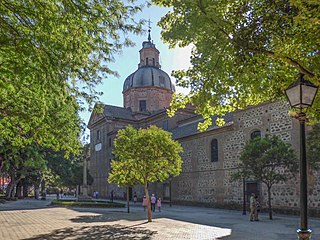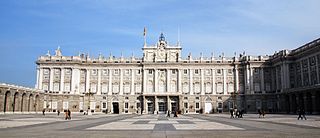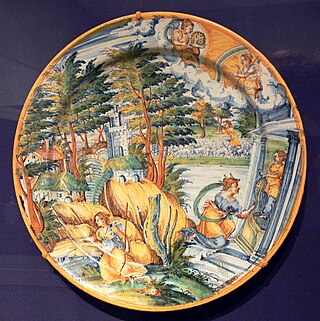
Puebla de Zaragoza, formally Heroica Puebla de Zaragoza, formerly Puebla de los Ángeles during colonial times, or known simply as Puebla, is the seat of Puebla Municipality. It is the capital and largest city of the state of Puebla, and the fourth largest city in Mexico, after Mexico City, Monterrey, and Guadalajara. A viceregal era planned city, it is located in the southern part of Central Mexico on the main route between Mexico City and Mexico's main Atlantic port, Veracruz—about 100 km (62 mi) east southeast of Mexico City and about 220 km (140 mi) west of Veracruz.

Talavera de la Reina is a city and municipality of Spain, part of the autonomous community of Castile–La Mancha. Its population of 83,303 makes it the second most populated municipality of the province of Toledo and the fourth largest in the region.

Maiolica is tin-glazed pottery decorated in colours on a white background. The most renowned Italian maiolica is from the Renaissance period. These works were known as istoriato wares when depicting historical and mythical scenes. By the late 15th century, multiple locations, mainly in northern and central Italy, were producing sophisticated pieces for a luxury market in Italy and beyond. In France, maiolica developed as faience, in the Netherlands and England as delftware, and in Spain as talavera. In English, the spelling was anglicised to majolica, but the pronunciation usually preserved the vowel with an i as in kite.

Azulejo ; from the Arabic al-zillīj, الزليج) is a form of Portuguese and Spanish painted tin-glazed ceramic tilework. Azulejos are found on the interior and exterior of churches, palaces, ordinary houses, schools, and nowadays, restaurants, bars and even railways or subway stations. They are an ornamental art form, but also had a specific functional capacity like temperature control in homes.

The Catedral de la Asunción de la Virgen, popularly known as New Cathedral is, together with the Old Cathedral, one of the two cathedrals of Salamanca, Castile and León, Spain. It is the seat of the diocese of Salamanca. It was constructed between 1533 and 1733 mixing late Gothic, Plateresque and Baroque styles. It was commissioned by Ferdinand V of Castile. It is one of the largest cathedrals in Spain in size and its bell tower, at 92 meters high, is also one of the tallest.

Spanish architecture refers to architecture in any area of what is now Spain, and by Spanish architects worldwide. The term includes buildings which were constructed within the current borders of Spain prior to its existence as a nation, when the land was called Iberia, Hispania, or was divided between several Christian and Muslim kingdoms. Spanish architecture demonstrates great historical and geographical diversity, depending on the historical period. It developed along similar lines as other architectural styles around the Mediterranean and from Central and Northern Europe, although some Spanish constructions are unique.

Spanish Renaissance architecture was that style of Renaissance architecture in the last decades of the 15th century. Renaissance evolved firstly in Florence and then Rome and other parts of the Italian Peninsula as the result of Renaissance humanism and a revived interest in Classical architecture. In Spain, the Renaissance began to be grafted to Gothic forms as mathematicians and engineers rediscovered building as one of the technological sciences. In the time of King Felipe II (1556–1589), the Renaissance influence expanded throughout the territory thanks to the dissemination of architectural treatises.

Tin-glazed pottery is earthenware covered in lead glaze with added tin oxide which is white, shiny and opaque ; usually this provides a background for brightly painted decoration. It has been important in Islamic and European pottery, but very little used in East Asia. The pottery body is usually made of red or buff-colored earthenware and the white glaze imitated Chinese porcelain. The decoration on tin-glazed pottery is usually applied to the unfired glaze surface by brush with metallic oxides, commonly cobalt oxide, copper oxide, iron oxide, manganese dioxide and antimony oxide. The makers of Italian tin-glazed pottery from the late Renaissance blended oxides to produce detailed and realistic polychrome paintings.

Talavera pottery is a Mexican and Spanish pottery tradition from Talavera de la Reina, in Spain. In 2019, it was included in UNESCO's Representative List of the Intangible Cultural Heritage of Humanity.

The Casa de los Azulejos or Palacio de los Condes del Valle de Orizaba is an 18th-century Baroque palace in Mexico City, built by the Count of the Valle de Orizaba family. The building is distinguished by its facade, which is covered on three sides by blue and white colonial Talavera tiles from Puebla state. The palace remained in private hands until near the end of the 19th century. It changed hands several times before being bought by the Sanborns brothers who expanded their soda fountain/drugstore business into one of the best-recognized restaurant chains in Mexico. The house today serves as their flagship restaurant.

Mexican handcrafts and folk art is a complex collection of items made with various materials and intended for utilitarian, decorative or other purposes. Some of the items produced by hand in this country include ceramics, wall hangings, vases, furniture, textiles and much more. In Mexico, both crafts created for utilitarian purposes and folk art are collectively known as “artesanía” as both have a similar history and both are a valued part of Mexico's national identity. Mexico's artesanía tradition is a blend of indigenous and European techniques and designs. This blending, called “mestizo” was particularly emphasized by Mexico's political, intellectual and artistic elite in the early 20th century after the Mexican Revolution toppled Porfirio Díaz’s French-style and modernization-focused presidency. Today, Mexican artesanía is exported and is one of the reasons why tourists are attracted to the country. However, competition from manufactured products and imitations from countries like China have caused problems for Mexico’s artisans.

The Cathedral of Santa María, known as the Old Cathedral, is one of the two cathedrals in Salamanca, Castile and León, Spain. Founded by Bishop Jerome of Périgord, its construction began in the first third of the 12th century and was finished at the end of the 14th century, in Romanesque and Gothic style. It was finished thanks to the impulse given to the works by Bishop Alfonso Barasaque. It is dedicated to Saint Mary of the See.

Ceramics in Mexico date back thousands of years before the Pre-Columbian period, when ceramic arts and pottery crafts developed with the first advanced civilizations and cultures of Mesoamerica. With one exception, pre-Hispanic wares were not glazed, but rather burnished and painted with colored fine clay slips. The potter's wheel was unknown as well; pieces were shaped by molding, coiling and other methods,

The Museo Regional de la Cerámica in Tlaquepaque, Jalisco, Mexico is located on Independencia Street in the center of the city. The museum is one of two main ceramics museums in the city, with the other being the Pantaleon Panduro Museum. It was established in 1954 to preserve and promote indigenous handcrafts of Jalisco, especially the state’s ceramic tradition. The emphasis is still on ceramics but the museum also has a room dedicated to Huichol art and holds events related to various types of indigenous crafts and culture.
The Ducal Palace of Vila Viçosa is a royal palace in Portugal, located in the civil parish of Nossa Senhora da Conceição, in the municipality of Vila Viçosa, in the Alentejo, situated about 150 km east of the capital Lisbon. It was for many centuries the seat of the House of Braganza, one of the most important noble houses in Portugal. Braganza was the ruling house of the Kingdom of Portugal from 1640 until 1910, when King Manuel II, titular head of the family, was deposed in the 5 October 1910 Revolution which brought in a Republican government.

The Museo Nacional de Artes Decorativas is located at 12 Montalbán Street, in Madrid, Spain, to the south of the Puerta de Alcalá and the western side of the Buen Retiro Park. It is one of the oldest museums in the city, situated within the Golden Triangle of Art. Following the example of the Victoria and Albert Museum in London, it illustrates the evolution of industrial or "minor arts", including furniture, ceramics, glass, and textiles. The collections emphasize the 16th and 17th centuries in particular; its collection contains approximately 70,000 pieces. Its 62 exhibition rooms are within a palace near the Jardines del Retiro de Madrid. The museum received 71,472 visitors in 2017.

The architecture of Madrid has preserved the look and feel of many of its historic neighbourhoods and streets, even though Madrid possesses a modern infrastructure. Its landmarks include the Royal Palace of Madrid, the Royal Theatre with its restored 1850 Opera House, the Buen Retiro Park, the 19th-century National Library building containing some of Spain's historical archives, a large number of national museums, and the Golden Triangle of Art located along the Paseo del Prado and comprising three art museums: Prado Museum, the Reina Sofía Museum, and the Thyssen-Bornemisza Museum, which completes the shortcomings of the other two museums. Cibeles Palace and Fountain have become the monument symbol of the city.

Juan de Talavera was a Spanish architect, sculptor and carver, member of the "Toledo School of Architecture", and architect of Queen Isabella I of Castile. Probably his father was also named Juan de Talavera, and he was a nephew of Andrés de Talavera, both working in the Cathedral of Seville circa 1450. Juan de Talavera married Maria Gutierrez, daughter of Egas Coeman or Egas of Brussels and he was probably also a nephew of Juan Guas by his wife.

Puebla handcrafts and folk art is handcraft and folk art from the Mexican state of Puebla. The best-known craft of Puebla is Talavera pottery—which is the only mayolica style pottery continuously produced in Mexico since it was introduced in the early colonial period. Other notable handcraft traditions include trees of life from Izúcar de Matamoros and amate (bark) paper made by the very small town of San Pablito in the north of the state. The state also makes glass, Christmas tree ornaments, indigenous textiles, monumental clocks, baskets, and apple cider.

Chocolate Jar with Iron-Locked Lid is a piece of earthenware with tin-glaze. It was created in Puebla, Mexico, sometime between 1725 and 1775. It was made in the style of Talavera poblana developed out of the tradition in Talavera, Spain, and was also influenced by Chinese ceramic traditions. This vessel was used to house cacao beans. The jar is part of the Herbert Pickering Lewis Collection of Mexican Pottery at the Art Institute of Chicago and has been included in a handful of exhibitions.























